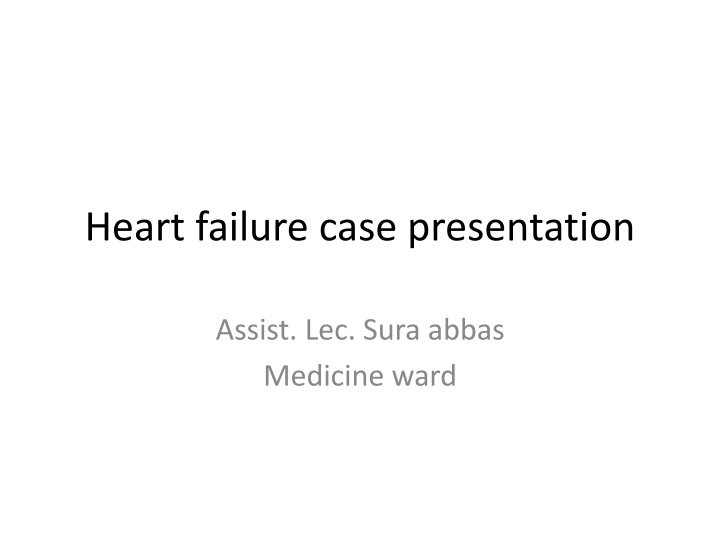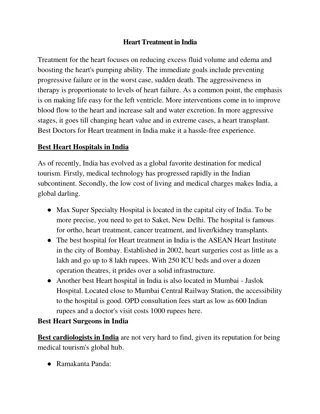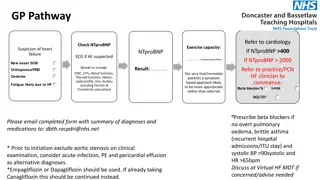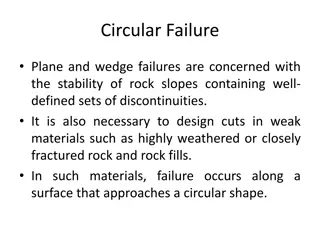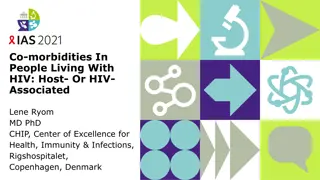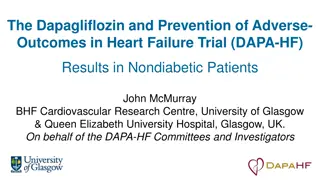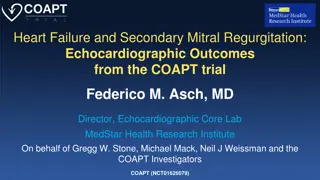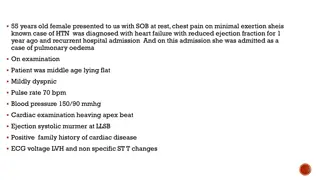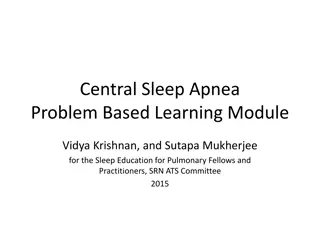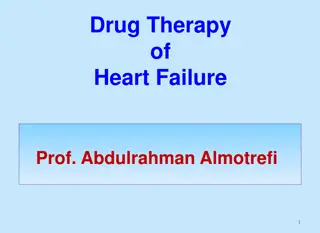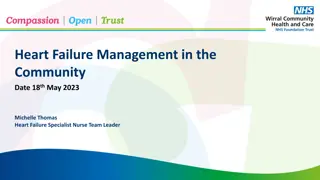Comprehensive Evaluation of Heart Failure in a 68-Year-Old Man with Co-Morbidities
A 68-year-old man with a history of CAD, type 2 diabetes, and other comorbidities presents with symptoms suggestive of heart failure. His chief complaints include dyspnea, orthopnea, lower extremity edema, and decreased exercise tolerance. Through medical history, physical examination, and diagnostic tests, evaluation reveals reduced EF, prominent pleural effusions, hepatojugular reflux, and cardiomegaly. Laboratory values show abnormalities. Further management and treatment planning require additional information and consideration of his complex medical background and lifestyle factors.
Download Presentation

Please find below an Image/Link to download the presentation.
The content on the website is provided AS IS for your information and personal use only. It may not be sold, licensed, or shared on other websites without obtaining consent from the author.If you encounter any issues during the download, it is possible that the publisher has removed the file from their server.
You are allowed to download the files provided on this website for personal or commercial use, subject to the condition that they are used lawfully. All files are the property of their respective owners.
The content on the website is provided AS IS for your information and personal use only. It may not be sold, licensed, or shared on other websites without obtaining consent from the author.
E N D
Presentation Transcript
Heart failure case presentation Assist. Lec. Sura abbas Medicine ward
Chief complaints A 68-year-old man with a history of known CAD and type 2 diabetes mellitus presents for a belated follow-up clinic visit (his last visit was 2 years ago). His most bothersome complaint is SOB at night when lying down flat; he has to sleep on three pillows to get adequate rest and sometimes even that does not help. Although he used to be able to walk a few blocks and two to three flights of stairs comfortably before getting breathless, he has had increasing symptoms after one flight of stairs. He also notes his ankles are always swollen and his shoes no longer fit; therefore he only wears slippers. Additionally, he has difficulty finishing his meals due to bloating and nausea, and overall his appetite is decreased. What information is suggestive of a diagnosis of HF? What additional information do you need to know before creating a treatment plan?
Medical History, Physical Examination, and Diagnostic Tests PMH: Dyslipidemia 20 years, type 2 diabetes mellitus coronary artery disease 10 years (MIs in 1999 and 2002), history of alcohol abuse 30 years, history of migraines 40 years Allergies: No known drug allergies Meds: Diltiazem CD 240 mg once daily, nitroglycerin 0.4 mg sublingual as needed (last use yesterday after showering), glipizide 10 mg twice daily for diabetes, metformin 1000 mg twice daily atorvastatin 40 mg once daily for dyslipidemia, naproxen 220 mg twice daily as needed vitamin B12 once daily, multivitamin daily, aspirin 81 mg once daily FH: Significant for early heart disease in mother (MI at age 63) SH: He is disabled from a previous accident; he is married, has children, and business; he drinks 10 to 12 beers nightly 15 years, three own runs his for diabetes, for headaches,
Physical examination BP 126/84 mm Hg, pulse 60 beats/min respiratory rate 16/min, Ht 5 8 (173 cm), Wt 251 lb (114 kg), body mass index (BMI): 38.2 kg/m2 Lungs are auscultation prolonged expiratory phase CV: Regular rate and rhythm with normal S1 and S2; there is an S4 present Abd: Soft, nontender, and bowel sounds are present, (+) hepatojugular reflux Ext: 2+ pitting edema extending to below the knees is observed. JVP 11 cm Chest x-ray: Bilateral pleural effusions and cardiomegaly Echocardiogram: EF = 25% (0.25) and regular, clear with to a S3 and a soft
Laboratory Values Hct: 41.1% (0.411) WBC: 5.3 103/ L (5.3 109/L) Sodium: 136 mEq/L (136 mmol/L) Potassium: 3.2 mEq/L (3.2 mmol/L) Bicarb: 30 mEq/L (30 mmol/L) Chloride: 90 mEq/L (90 mmol/L) Magnesium: 1.5 mEq/L (0.75 mmol/L) Fasting blood glucose: 120 mg/dL (6.7 mmol/L) Uric acid: 8 mg/dL (476 mol/L) BUN: 40 mg/dL (14.3 mmol/L) SCr: 1.6 mg/dL (141 mol/L) Alk Phos: 120 IU/L (2.00 Kat/L) Aspartate aminotransferase: 100 IU/L (1.67 Kat/L)
questions What other laboratory or diagnostic tests are required for assessment of the patient s condition? How would you classify his NYHA FC and ACC/AHA HF stage? Identify exacerbating or precipitating factors that may worsen his HF. What are your treatment goals for the patient?
HINT Based on the information presented and your problem-based assessment, create a care plan for the patient s HF. Your plan should include: Nonpharmacologic treatment options. Acute and chronic treatment plans to address symptoms and prevent disease deterioration. Monitoring plan for acute and chronic treatments.
Acute heart failure After 6 months, the patient returns to the clinic complaining of extreme SOB with any activity, as well as at rest. He sleeps sitting up due to severe orthopnea, can only eat a few bites of a meal and then feels full and nauseous, and states he has gained 22 lb (10 kg) from his baseline weight. He is also profoundly dizzy when standing up from a chair and bending over. He states that he does not feel his furosemide therapy is working. He is admitted to the cardiology unit. SH: Admits to resuming previous alcohol intake; additionally, he has been eating out in restaurants more often in the past 2 weeks Meds: Atorvastatin 40 mg once daily, lisinopril 10 mg once daily, furosemide 80 mg twice daily, glipizide 10 mg twice daily for diabetes, metformin 1000 mg twice daily for diabetes, nitroglycerin 0.4 mg sublingual as needed, multivitamin daily, aspirin 325 mg daily
Physical examination VS: BP 96/54 mm Hg, pulse 102 beats/min and regular, respiratory rate 22/minute, temperature 37 C (98.6 F), Wt 273 lb (124 kg), BMI 41.5 kg/m2 Lungs: There are rales present bilaterally CV: Regular rate and rhythm with normal S1 and S2; there is an S3 and an S4; a 4/6 systolic ejection murmur is present
jugular veins are distended, JVP is 11 cm above sternal angle Abd: Hard, tender, and bowel sounds are present; 3+ pitting edema of extremities is observed CXR: Bilateral pleural effusions and cardiomegaly Echo: EF = 20% (0.20) Pertinent labs: BNP 740 pg/mL (740 ng/L; 214 pmol/L),?
Lab data K: 4.2 mEq/L (4.2 mmol/L), BUN 64 mg/dL (22.8 mmol/L), SCr 2.4 mg/dL (212 mol/L), Mg 1.8 mEq/L (0.9 mmol/L); A pulmonary catheter is placed, revealing the following: PCWP 37 mm Hg (4.9 kPa); CI 2.3 L/min/m2 What NYHA functional class, ACC/AHA stage, and hemodynamic subset is the patient currently in? What are your initial treatment goals? What pharmacologic agents are appropriate to use at this time? Identify a monitoring plan to assess for efficacy and toxicity of the recommended drug therapy. Once symptoms are improved, how would you optimize oral medication therapy for this patient s HF
